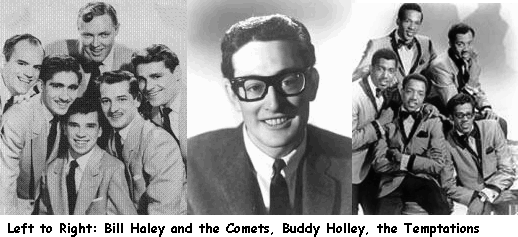
Although fifty years ago we called our music "rock and roll," it was really different from contemporary rock music. To begin with, the musicians looked different. Short hair, black, pearl-gray or white tuxedo jackets or sports coats, pink carnations in the lapel -- in matching get-ups like such famous performers of the era as Buddy Holly or Bill Haley or the Temptations really looked nerdy by today's standards. Another big difference was the instrumentation of typical bands. A 1950's band composed of a trumpet, two saxophones, a stand- up "slap" bass fiddle, a drum set, a piano and maybe one unamplified acoustic guitar really makes music sound odd to young modern ears used to four or five amplified guitars, a couple of keyboards or synthesizers, sound-mixing boards and all the other electronic musical gadgets available today. Perhaps the biggest difference between music then and now was the simpler sound of the older music. Nearly all early "rock and roll" was based on a simple three-chord progession, usually the same old C-F-G chords familiar in the bass notes of a typical "boogie- woogie" song. Any idiot who could learn those three chords could play in a "rock and roll" band. Today's musicians, however, usually deal with ten to fifteen different chords in any typical popular song. Modern popular music is so very much more sophisticated musically than the stuff I listened to in high school that only real musicians can handle the complicated sounds of today. In a word, " rock and roll" was not very much like today's music.
Comments: In the paragraph above, the various colored fonts indicate the various parts of a typical Stage One one-paragraph essay: The first and last sentences are green. This indicates the opening topic sentence and the closing re-worded topic sentence. The next section is in blue. This indicates the first part of the support for the topic sentence. The next section is orange. This indicates the second part of the support of the support for the topic sentence. The next section is red. This indicates the third part of the support for the topic sentence.